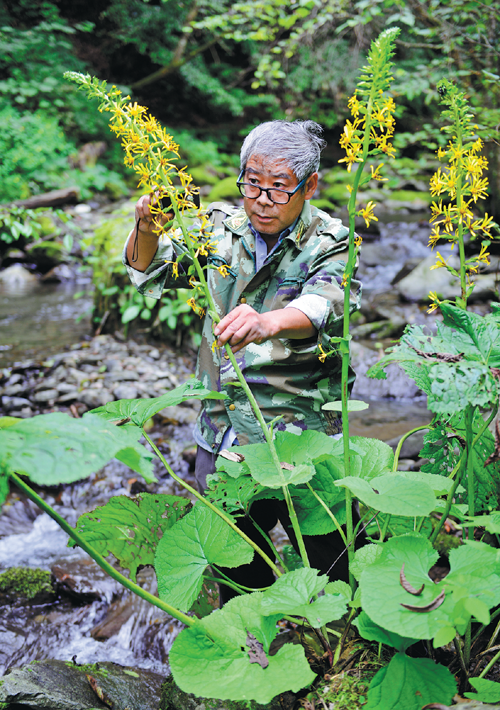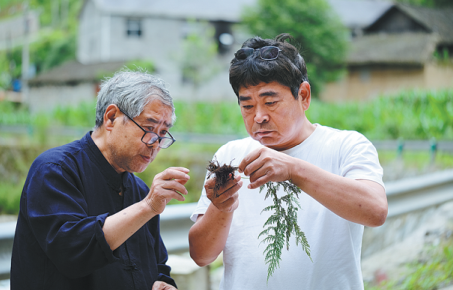A grass roots expert
Botanist without any formal qualification enhances our knowledge of the natural world, Yang Feiyue reports.

Anyone trekking in the lush mountain areas of Zhuxi county in Central China's Hubei province would be likely to catch a glimpse of a gray-haired man carrying a bag of tools on a treasure hunt for nature's bounty.
Gan Qiliang's life revolves around exploring the wilderness across the province.
"I will survey the plants and collect samples," says the 70-year-old, who clearly knows his way around the woods, despite being off the beaten track, after two decades negotiating them.
He normally leaves for the forest early in the morning and works until dusk.
"If the weather is not right for hiking, I'll stay in the lab, sorting out my notes," he adds.
To date, Gan has managed to identify more than 3,800 plant species in Zhuxi, on the border of Shaanxi province and Chongqing municipality.
The county abounds in verdant forests and is considered a "green gene" treasure trove among experts, including Wu Zhengyi, a renowned botanist in China.
Shibalichangxia National Nature Reserve, one of the key areas of the county, is a site that Gan has frequented the most over the years.
It sits in the south of the county and boasts about 50 mountain peaks, each of which stands more than 2,000 meters above sea level. The vast drop in elevation and lack of people have given rise to an abundance of fauna and flora both in the valleys and on the mountains.
In mid-January, the international botany journal Annales Botanici Fennici published Gan's findings about Hemsleya revoluta, a new species from the county that belongs to the gourd family.
The work resulted from Gan's collaboration with other botanical experts. He first noticed the local plant more than 10 years ago.
"I consulted with a few botany experts who gave different answers," he says. However, he found slight disparities in the appearance of the local plant and the other species mentioned by the experts.
"It's tricky to categorize plants, not just by their appearance, root and branches and all, but through DNA analysis in some cases," he explains.
Some locals had empirically used the plant for treating stomach discomfort, although no medical research has proved the validity of such treatment.
After further studies, Gan and his teammates came to the conclusion that the plant was one that hadn't yet been recognized in academic circles.
"Its discovery will be helpful for future medical research and also the protection of the plant species," he says.
Gan's love of plants has spurred him to embark on a fruitful second career after retirement.
He has been intrigued by the power in plants since childhood, when he witnessed how some of his friends failed to resist the allure of the fragrant yet poisonous Coriaria nepalensis fruit and passed out after eating it. It was thanks to the timely delivery of a mysterious herbal cocktail concocted by local adults that his friends regained consciousness.
Plants kept casting a spell on him through other mundane affairs in the rural area.
"I watched some parents apply herbs to bee stings on their children, and it worked," Gan says.
From then on, he made a point of inquiring about those plants.
"I wanted to know which plants are edible, which ones are medicinal and which ones are poisonous," he says.
By the time he reached high school, he sought books about plants, including Bencao Gangmu (Compendium of Materia Medica), an encyclopedic work of medicine and natural history written by Li Shizhen in the Ming Dynasty (1368-1644).
"I wanted to be of some use, because doctors were rare in villages back then."
Gradually, he could identify more than 500 plants which boasted medicinal effects.
In 1972, Gan got a job at the county's publicity department and had been covering stories across the county. When he was in the mountains, he observed plants at close quarters. When he met locals suffering from various ailments and having difficulty finding a doctor, he helped them with his herbal knowledge.
As his experience with plants grew, in the 1990s, Gan started to view existing information about his hometown with a critical eye.
"It just didn't feel right to read in all introduction materials that Zhuxi county has only about 900 plant species," Gan says.
Following a surgery and his retirement from work in 1999, he decided to get to the bottom of it.
After recuperating, he started off his journey of plant studies at Shibalichangxia in 2001.
He prepared food and drove an old jeep into the valley. Whenever he found a plant he hadn't seen before, he took pictures and samples of it, while noting its features.
He was often exposed to danger, especially in the beginning. He had several close calls in his jeep as he maneuvered it along the perilous mountain paths.
Over the following four years, Gan left his footprints over all of Shibalichangxia nature reserve and produced nearly 10,000 photos and several reams of notes. To ascertain plant distribution and mutation, Gan dug into his own pocket and visited experts from Beijing, Wuhan in Hubei province, and Kunming in Yunnan province.
At first, experts taught him how to make standard specimens after seeing that some of his samples were as big as a newspaper page.
They reminded Gan of what standard samples should look like, and that it's better to merely accentuate key features rather than the whole plant. "Then I realized herbal plants need roots, while the woody ones should have blossoms and fruits when making a sample," he says.
Gan's commitment has made him friends with many scholars and experts in botanical circles. They have helped Gan refer to the documents and identify the plants he brought in.
In 2005, Gan finished his first magnum opus Flora of Zhuxi, which includes colorful images, characteristics, geographic distribution and the economic value of more than 2,200 plants in the county.
The published tome caused a sensation in the field. Guo Youhao, a botanist and professor from Wuhan University, says: "It's no easy job surveying plant resources and categorizing them.
"It's completely beyond my expectations that the Flora of Zhuxi is such a good job."
In 2006, Gan's book won the second provincial science and technology prize in Hubei. Yet, Gan didn't plan to rest on his laurels.
"There may be more plants waiting to be discovered or for their existence to be proved, as recounted by our ancestors," he says.
In March 2007, he hit the road again. It led to a discovery of more than 1,400 plants, all of which he wrote about in a 2011 supplement to Flora of Zhuxi.
Among the newly found species, the Primula filchnerae that had once been considered extinct and the Berchemiella wilsonii that had not been seen for nearly a century took academia by storm.
According to experts, his efforts have not just enhanced the record of plants in Zhuxi, but enriched the collection of plants in China and the rest of the world.
His years of experience in the natural environment has also impelled him to help raise public awareness of wildlife protection.
"Biodiversity preservation should start from a tuft of grass," he says, adding that it would mean a lot for ecological balance, if more people are more aware of it.
Because of his work, Zhuxi county has set up three natural reserves, a national forest park and a national wetland protection area.
From a layman without any academic qualifications under his belt, botanist Gan has certainly made his presence felt. Yet, he doesn't consider himself a scholar or a doctor.
"I'm just a big fan of plants and an adventurer in the botanical world," he says.




Today's Top News
- Huangyan approved as nature reserve
- Establishment of Huangyan Island nature reserve safeguards its marine environment
- Defense minister: Containment efforts unworkable
- Huangyan Island National Nature Reserve gets official go-ahead
- Defense leaders from over 100 countries to attend Xiangshan Forum
- China honors model teachers in celebration of Teachers' Day






























